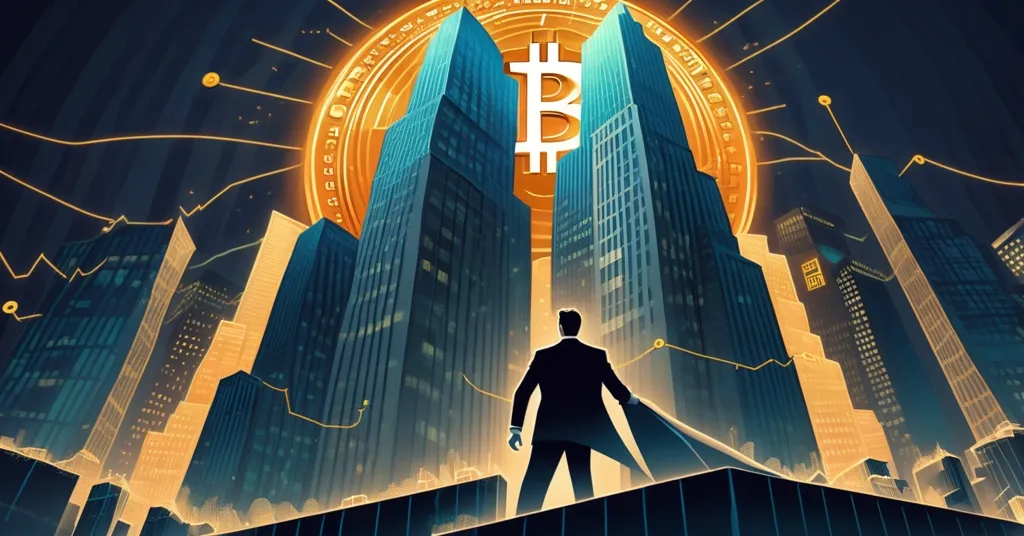Goldman Sachs’ S&P 500 Bullish Outlook: Bitcoin and Crypto Impact for 2025

Goldman Sachs’ S&P 500 Bullish Forecast: What It Means for Bitcoin and Crypto in 2025
Wall Street is riding a wave of optimism as Goldman Sachs unveils a bullish outlook for the S&P 500, projecting hefty gains over the next year, powered by expected Federal Reserve rate cuts. For the crypto crowd, this isn’t just stock market chatter—it’s a potential signal of tailwinds for Bitcoin and digital assets as liquidity floods the system. Let’s cut through the noise and see how this traditional finance hype could shake up the decentralized world.
- S&P 500 Gains: Goldman predicts returns of over 3% in 3 months (target: 6,400), 6% in 6 months (target: 6,600), and 11% in 12 months (target: 6,900).
- Fed Rate Cuts: Anticipated to start in September with 25 basis point reductions, possibly ending by June 2025 with rates at 3.5%-3.7%.
- Crypto Impact: Increased liquidity could fuel risk appetite, boosting Bitcoin and altcoins, but volatility and macro risks loom large.
Goldman’s S&P 500 Crystal Ball: What’s Fueling the Optimism?
Goldman Sachs, a titan of Wall Street, has dropped a forecast that’s turning heads: the S&P 500, an index tracking 500 of the largest U.S. companies, is set for significant growth over the next year. Their numbers are bold—over 3% returns in just three months, climbing to 6% by mid-2025, and topping 11% by next fall, with the index expected to hit 6,900. What’s behind this rosy picture? A mix of anticipated Federal Reserve moves, strong showings from large-cap tech giants, and a belief that corporate earnings will hold steady with a projected 7% earnings-per-share growth for both 2025 and 2026. But it’s not all sunshine—the bank is keeping an eye on Q2 earnings for any hiccups that might derail this trajectory.
The big driver here is the Fed. Starting in September, Goldman expects the U.S. central bank to begin slashing interest rates by 25 basis points—that’s a quarter of a percent—across its next few meetings, potentially wrapping up by June 2025 with policy rates settling between 3.5% and 3.7%. For those new to the game, lower interest rates mean cheaper borrowing, which pumps more money into the economy, encouraging spending and investment. Goldman’s Chief Strategist, David Kostin, put it sharply:
“Equities typically appreciate alongside rising bond yields when the market is raising its expectations for economic growth, but struggle when yields rise due to other drivers, like fiscal concerns.”
Translation: stocks often thrive when yields—basically the return on government debt—climb due to a strong economy. But if yields spike because of worries over government debt or fiscal mess, equities can tank. Goldman warns that a 5% nominal yield could be a breaking point for U.S. stocks, and that’s a red flag for riskier plays like crypto too, since Bitcoin often moves with the broader appetite for high-stakes bets.
Fed Rate Cuts 101: Cheaper Money, Bigger Gambles?
Let’s zoom in on these rate cuts. When the Fed lowers rates, it’s like opening the floodgates of liquidity—money gets cheaper, and investors start hunting for bigger returns beyond sleepy savings accounts or bonds. Historically, this has been a boon for speculative assets. Rewind to 2020: amid the COVID-19 chaos, the Fed dropped rates to near zero, and Bitcoin exploded from under $10,000 to over $60,000 in a year. Why? Lower rates slash the opportunity cost of holding non-yielding assets like BTC, unlike bonds that lose their luster when returns shrink. For deeper insights, check out community discussions on how Fed rate cuts influence Bitcoin.
Contrast that with tightening cycles. Back in 2015-2016, when the Fed hiked rates, Bitcoin and other risk assets stumbled as capital flowed to safer havens. The current forecast of cuts signals a return to “easy money” mode, which could juice up markets. But here’s the catch—Goldman expects bond yields to stay flat through 2025. If they creep up due to fiscal fears rather than growth, as Kostin noted, the party could end early for stocks and, by extension, digital currencies that thrive on risk hunger.
Risks on the Horizon: Tariffs and Recession Shadows
Not everything’s a slam dunk. Geopolitical headaches, like Trump’s proposed tariffs, are the uninvited guest at this bullish bash. While Goldman downplays the near-term sting—arguing large corporations are stockpiling inventory to buffer the impact on consumers—they admit the effects could creep into earnings over time. Meanwhile, Ipek Ozkardeskaya from Swissquote Bank isn’t buying the hype, calling the market’s optimism “suspicious” and warning that tariffs could still screw up supply chains, growth, and inflation. Add to that a 35% chance of a U.S. recession, per Goldman’s estimates, and you’ve got a recipe for jitters that could hit speculative corners like crypto harder than most.
Then there’s the question of market breadth. The S&P 500’s rally is powered by a narrow group of heavyweights—think tech behemoths—while the rest lag behind. With the forward price-to-earnings ratio jumping to 22 from 20.4, there’s a whiff of overvaluation in the air. If these top dogs stumble, the whole index could wobble, and Bitcoin, often a leveraged bet on global risk mood, might take a nastier fall. For context, “market breadth” is about how many stocks are driving gains—if it’s just a handful, a slip by those leaders spells trouble for everyone, including us in the crypto trenches. You can explore more about analyst views on S&P 500 bullish trends for additional perspective.
Bitcoin’s Dance with Wall Street: Tailwinds and Tripwires
So, how does this Wall Street optimism translate to Bitcoin? Rate cuts and a bullish S&P 500 often signal a broader appetite for bold plays. When liquidity spikes, investors chase outsized returns, and Bitcoin—sometimes called “digital gold” for its role as a store of value outside fiat systems—tends to shine. A thriving tech sector in the S&P 500 also hints at spillover potential for blockchain-related stocks like Coinbase or MicroStrategy, which can drag BTC’s price along for the ride. There’s a notable correlation between Bitcoin prices and S&P 500 trends that underscores this dynamic.
But let’s not get carried away with moonshot fantasies. Crypto markets swing wildly, often amplifying traditional finance’s ups and downs. If tariff tensions flare or recession fears grow beyond current odds, risk-averse capital could flee to safer shores, leaving Bitcoin and its peers battered. And while we’re on the topic of hype, let’s be clear: I’m not here to peddle snake oil with some ridiculous “BTC to $100K by Christmas” nonsense. That kind of baseless shilling is trash, and we’re better than that. What matters is the messy reality—macro trends like rate cuts can create tailwinds, but they’re no golden ticket in a landscape where volatility rules.
Altcoins in the Mix: Beyond Bitcoin’s Shadow
Bitcoin isn’t the only player in town. Altcoins—alternative cryptocurrencies like Ethereum, Solana, and others—could also catch a lift from Fed-fueled liquidity. Ethereum, for instance, offers staking yields post its 2022 Merge upgrade, where users lock up ETH to validate transactions and earn rewards. In a low-rate world, these yields can look tastier than bonds, drawing capital. Solana, with its high-speed, low-cost blockchain, is a magnet for decentralized finance (DeFi) projects that might boom if cheap money accelerates innovation. Curious about broader impacts? See how rate cuts influence crypto investments for varied opinions.
Still, altcoins are often riskier than BTC, acting as high-octane bets on niche tech. If the S&P 500’s tech rally falters due to overvaluation, these smaller coins could crash harder. And let’s not ignore the dark underbelly—bullish markets often breed scams and rug pulls, especially with meme coins or unvetted projects promising the moon. If liquidity pours in, vet every altcoin play like your wallet depends on it. We’ve seen too many suckers burned by hype during past bull runs.
Decentralization’s Long Game: Why Rate Cuts Don’t Fix Fiat Flaws
From a Bitcoin maximalist vantage point, Fed rate cuts are a double-edged sword. On one hand, they might pump BTC’s price short-term as liquidity seeks high returns. On the other, they highlight why many of us back decentralization in the first place—central banks keep meddling to prop up a flawed fiat system. Every rate tweak is a reminder of their heavy hand, manipulating money supply while Bitcoin’s hardcoded cap of 21 million coins stands as a middle finger to endless printing. For more on the expected Fed rate cuts and their implications for crypto liquidity, community debates offer raw takes.
Playing devil’s advocate, though, does temporary economic stability from rate cuts weaken Bitcoin’s case as a hedge against fiat collapse? Maybe for now. If markets hum along, fewer folks might feel the urgent need for a decentralized escape hatch. But long-term, liquidity injections often stoke inflation—look at post-2008 trends—and that’s where BTC’s scarcity bites back as a counterweight. Plus, from an effective accelerationism angle, cheap capital could supercharge blockchain innovation. Think DeFi protocols on Ethereum or layer-2 scaling solutions slashing transaction costs. Sure, some junk projects might get overfunded, diluting quality, but the potential for real disruption? That’s the kind of chaos we’re here for.
Key Takeaways and Questions for Crypto Enthusiasts
- How Could Fed Rate Cuts Impact Bitcoin Prices in 2025?
Lower rates flood markets with cheap money, making non-yielding assets like Bitcoin more alluring for speculative gains. Past surges, like 2020’s rally from $10K to $60K, suggest upside, but volatility could spark brutal pullbacks if risk mood sours. - Will a Bullish S&P 500 Lift Altcoin Markets Too?
Usually, yes—S&P 500 gains signal a hunger for growth that spills into altcoins like Ethereum or Solana, especially those tied to DeFi or scalability. But if stock overvaluation triggers a correction, altcoins could nosedive as leveraged plays. - Are Trump’s Tariffs a Real Threat to Crypto Investments?
They’re a wildcard. Goldman downplays short-term pain, but escalating trade wars could rattle economic stability, spook investors, and tank risk assets like Bitcoin. Crypto’s hypersensitivity to macro shocks means staying sharp is non-negotiable. - What Do Central Bank Moves Mean for Decentralization’s Future?
Fed tinkering exposes fiat’s fragility, bolstering Bitcoin’s case as a censorship-resistant alternative. Yet, short-term stability from cuts might slow mass adoption if fiat seems “safe enough” for now—a bitter irony for maximalists. - How Should Crypto Investors Position for Liquidity Inflows?
With capital potentially flooding in, consider dollar-cost averaging into Bitcoin or vetted altcoins to dodge wild swings. Eye tech-heavy S&P 500 sectors for crossover plays—like NVIDIA’s mining tech—but steer clear of scams promising absurd moonshots.
Navigating the crossroads of Wall Street forecasts and crypto potential demands a steady hand. Fed rate cuts and Goldman Sachs’ S&P 500 predictions could channel capital into Bitcoin and beyond, especially as investors hunt outsized gains in a low-yield environment. Yet, risks—from tariff flare-ups to overvalued markets—scream that crypto isn’t a free pass to riches. As advocates of decentralization, each central bank move nudges us to question the status quo, even if the road is rough. Stick to fundamentals, ditch the hype, and keep building the financial revolution we’re all rooting for.



